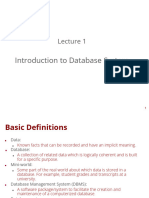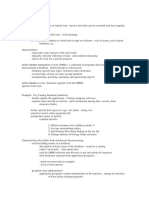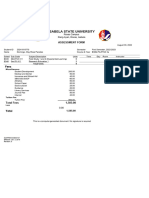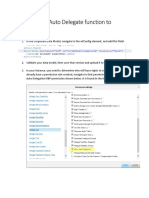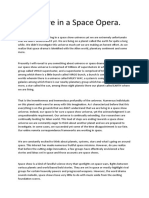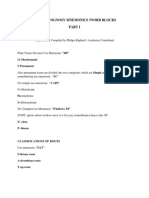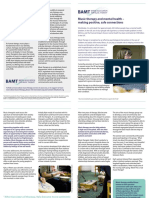dbms
INTRODUCTION
1) drawbacks of using file system
data redundancy and inconsistency
difficulty in accessing data
data isolation
integrity problems
atomicity of updates
concurrent access by multiple users
security problems
2) what is a database
collection of related data
data - known facts that can be recorded and have implicit
meaning
3) properties of a database
represents some aspects of real world or miniworld or
universe of discourse (UoD)
logically coherent collection of data with inherent meaning
designed, built and populated with data for a specific
purpose
data has some source, there is some degree of interaction
with events in real world and there is an audience
interested in the contents of the database
can be of any size and complexity
dbms 1
� may be generated and maintained manually or may be
computerised
4) what is a DBMS
computerised system that enables users to create and
maintain a database
general purpose software that facilitates the process of
defining, constructing, manipulating and sharing of
databases among various users and applications
defining - stating constraints, data structures and
types to be stored in the DB
DB catalog or dictionary - meta data
constructing - process of storing data on some storage
medium that is controlled by DBMS
manipulating - querying DB to retrieve specific data,
update DB to reflect changes in miniworld and generate
reports from data
sharing - users and programs allowed access to DB
simultaneously
5) what is a query
causes some data to be retrieved
6) what is a transaction
causes some data to be read and some data to be written
into DB
7) what does DB provide
protection -
* system protection against hardware and software
malfunction
dbms 2
� * security protection against unauthorised or malicious
access
8) characteristics of DB approach
self describing nature of DBS
use of meta data since general purpose DBMS is not written
to serve a specific purpose
structure of the data files is stored in the DBMS catalog
separately from access programs in DBS and this property is
called program data independence
program operation independence - user application programs
can operate on the data by invoking operations through
their names and arguments regardless of how the operations
are implemented
insulation between programs and data, data abstraction
data abstraction - characteristic that allows program data
independence and program operation independence is called
data abstraction
DBMS provides user with conceptual representation of data
that does not include many details as to how operations are
implemented
data model - type of data abstraction that is used to
provide conceptual representation
support of multiple views of data
DB has many users and each may need different view of DB
view - may be subset of DB or may contain virtual data that
is different from DB files but is not explicitly stored
sharing of data and multiuser transaction processing
must include concurrency control software to ensure several
users trying to update same data do so in a controlled
manner
DBMS must enforce certain transaction properties
(atomicity, consistency, insulation and durability)
dbms 3
� 9) actors on the scene
database administrators (DBA)
administering the resources - DB, DBMS software
responsible to handle security breaches and poor system
response time
authorise access to DB, coordinate and monitor its use,
acquire software and hardware resources as needed
database designers
identifying the data to be stored in the DB and choosing
appropriate structures to represent and store the data
communicating with all DB users to understand their
requirements and create a design accordingly
develop views of the DB that meet data and processing
requirements of each potential group of users
end users
people whose jobs require access to DB for querying,
updating and generating reports
3 types of end users
casual end users - occasional access and use
sophisticated db query language to specify their
requests
naive or parametric end users - constant querying and
updating DB and use standard types of queries and
updates called canned transactions
sophisticated end users - thoroughly familiarise
themselves with facilities of DBMS to implement their
own applications to meet complex requirements
system analysts and application programmers
system analysts - determine requirements of end users
especially naive and parametric end users and develop
dbms 4
� specifications for standard canned transactions that
meet these requirements
application programmers - implement these specifications
as programs and then test, debug, document and maintain
these canned transactions
10) advantages of DBMS approach
controlling redundancy
in file system there could be multiple file formats and
hence duplication of information in different files which
results in duplication of effort, wastage of space and
inconsistency.
restricting unauthorised access
when multiple users share DB, most users are not authorised
to access all info
some may only be allowed to retrieve data whereas others
can retrieve and update DB
DBMS provides a security and authorisation subsystem which
DBA uses to create accounts and specifies account
restrictions
providing persistent storage for program objects
object oriented DBS uses DBMS to store complex data
structures- this object is said to be persistent
providing storage structures and search techniques for
efficient query processing
DB is stored on disk, DBMS provides specialised data
structures and search techniques to speed up disk search
for desired records
indexes are based on tree data structure or hash data
structure that are suitable modified for disk search
providing backup and recovery
dbms 5
� permitting inferencing and actions using rules
providing multiple user interfaces
enforcing integrity constraints
dbms 6





























